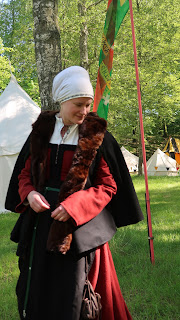Kirtle/Unterrock
The kirtle, or the unterrock in german, was part of everyday clothing for all classes of society during the 16th century. It could be partly visible with a decorative hemline under a gown or used with a jacket and an apron. The decorative trimmings were regulated by sumptuary laws.
Gown/Rock
Among the numerous variations the gown, or Rock in german, the one-piece woman´s dress, was the overall most frequent used. (During the 16th century this started to change, with the loose skirt and jacket.) The deep and wide cut on the shoulder neckline was regulated in the sumptuary laws. Therefore, if your neckline was to low, you needed to wear a high-necked hemden/shirt or a gollar. The trimmings was for decoration and according to class. The sumptuary law regulated with detailed gradations the material and width of allowed trims for the different classes. If you wore a trim to wide you could get a vanity penaltie. Nurnberg regislation stated in 1536 that trimmings of expensive fabric could be used on the upper body - at the neckline and on the sleeveends. The most common material for the gown, for all social classes, was different kinds of wool and wool blends.
In this picture Im wearing my gown/rock on top of my kirtle. Its made in red twill with a black twill trimming. The neckline is quite low so Im wearing a linen undergollar with embroideries, made like this. The embroideries comes from a painting from 1530 of Katharina von Bora, the wife of Martin Luther. And also a black apron in thin black wool, a very common colour for aprons during this time. The gown and kirtle are not made to be used together. Therefore the kirtle got a bit more fancy trimmings in velvet. It should might have been the other way around. The sleeves are a bit long, but it is made to be able to put my hands in there when Im cold.
Steuchlein
The
most common headwear for woman during this period is the wulsthaube with a veil, and later on a haube. The complete headdress consisted of an under coif/cap (Unterhaube) and a
veil, which was likely known as the Steuchlein, and it
is the most frequently mentioned headdress in the clothing inventories through all the social classes in 16th century Germany. In
the first years of the 16th century the wulst is large in size. The
fashionable development of the headwear later saw a reduction in size.
Mine is quite small and is therefore not from the first decade, rather from 1520-30. The embroidery is from German Renaissance Patterns for Embroidery, a facsimile copy of Nicolas Bassée´s New Modelbuch of 1568. The embroidery is also the same as on the sleeve of the daughter of Jakob Meyer in the painting The Darmstadt Madonna from 1526-28.
Schaube/cloak
This garment were common for women during the early 16th century. It was not reserved for the upper classes, it depended on the materials used. They were often furlined and which kind of fur you were allowed to use was regulated. There were also unlined ones, for summer. According to Textiler hausrat wool became common as lining from the second decade of the century. In the end of the century yellow wool was apparently the predominate lining material.
My schaube is made from a patterns presented in Drei Schnittbucher, "Brides little schaube". The front collar and back yoke is cut gestalt creating a lovely high and warm collar. Its made of wool and lined with mink, a bit to fancy for me, I know. It has decorative buttons on each side of the openings in the sideseams.
And yes, I do wear another steuchlein in this picture, but I wanted to show you the back of the schaube and I didnt have a picture of that from the same occasion. But here you see the back yoke and the pleats in the back that occure when you fold the backpiece to the smaller yoke.
Literature:
Textilier hausrat
Drei Schnittbucher
German Renaissance Patterns for Embroidery
Foto: Linda Öhman and Malin From
Help with translation: Anna Malmborg
Foto: Linda Öhman and Malin From
Help with translation: Anna Malmborg







One of the best ways to layer your shirts is to start with a base layer. A base layer can be a tank top, t-shirt, or even a long-sleeved shirt. Once you have your base layer, you can add a second layer on top.
SvaraRaderaNo, nothing historical about that, so I would not wear that.
SvaraRadera